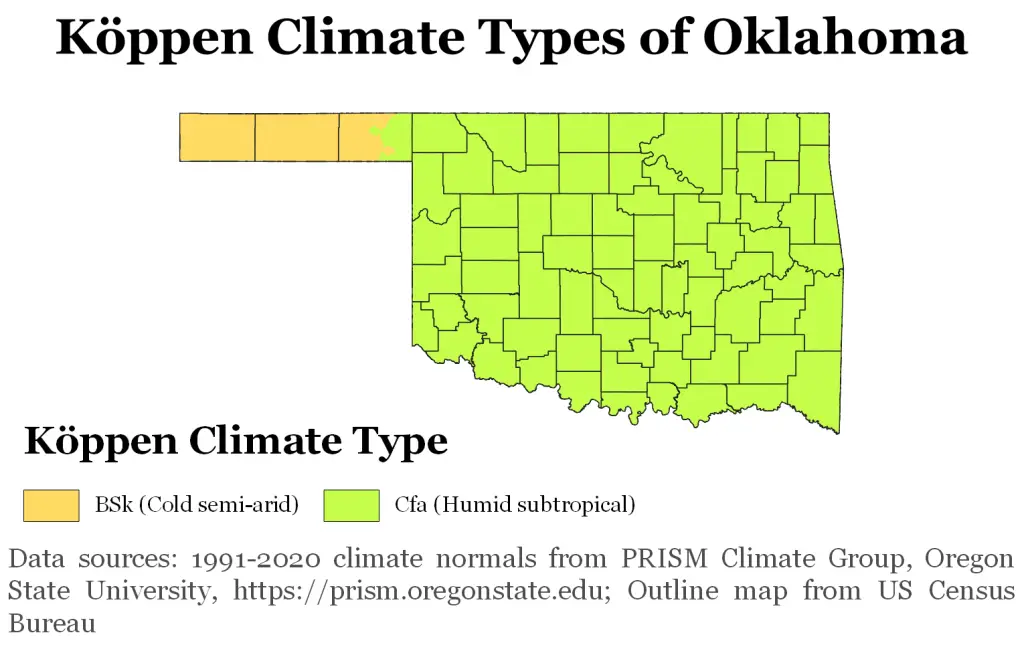Oklahoma Plant Hardiness Zones
| USDA Hardiness Zone | Average Minimum Extreme Winter Temperature Range Fahrenheit (°F) Celsius (°C) | Average Last Frost Date Range In Spring (Beginning Of The Growing Season) | Average First Frost Date Range In Autumn (End Of The Growing Season) |
|---|---|---|---|
| 6b | -5°F to 0°F -20.6°C to 17.8°C | Late April to early May | Early to mid-October |
| 7a | 0°F to 5°F -17.8°C to -15°C | Late April to early May | Mid to late October |
| 7b | 5°F to 10°F -15°C to -12.2°C | Early April to mid-April | Late October to early November |
| 8a | 10°F to 15°F -12.2°C to -9.4°C | Late March to early April | Early to mid-November |
Oklahoma Growing Conditions

General Climate
Oklahoma’s hardiness zones range from 6b to 8a. Most of the state is humid subtropical.
Oklahoma is a landlocked state but it is greatly affected by topical airflow that comes up from the Gulf of Mexico. This creates long, hot, and humid summers with cool and mild winters. Frost is infrequent and year-round growing in the state is possible.
Oklahoma’s west has a cold semi-arid climate. This type of climate is between desert and humid climates. These areas usually have slightly higher precipitation than desert climates. This contributes to the growth of grasses, brush, and woody plants.
Cold semi-arid climates have colder winters with the potential for freezing temperatures. High fluctuations between day and nighttime temperatures are common.
Microclimates
USDA plant hardiness zones are an important starting point for your garden, but you’ll also need to consider microclimates.
Microclimates are areas where specific conditions create a climate different from the climate they’re situated in.
Buildings, fences, paved areas, or short hills and valleys can create these microclimates.
They can be as small as a space in your backyard or as large as a city.
In other words, learn about your local conditions from local experts to see if your garden falls into a microclimate.
Extreme Weather
Tornadoes
Tornadoes are most common from April through June but can happen during any month of the year.
An average of 20 tornadoes pass through Oklahoma during the spring season.
Tornadoes are stressful when planning a garden. It’s true that luck has a lot to do with it. But a little planning, yearly pruning, and a Buddha-like detachment can go a long way to bring ease to a gardener’s mind!
Avoid trees with shallow root systems. Plant trees like oaks that have deep taproots that can withstand high winds.
Remove dead or damaged wood and wayward branches every year. This helps with breakage during storms. It also helps to avoid falling branches that can damage your property.
Drought
Drought is another extreme weather concern for gardeners who live in Oklahoma. It is a natural part of the seasonal climate in the state, especially in the west.
Planting drought-tolerant gardens is your best bet to combat the hot and dry weather. These gardens are low maintenance and need little water once established.
Native wildflower meadows are a great example of a drought-tolerant garden. Simply direct sow from seed into the garden in the fall and spring. They also provide beneficial habitat for butterflies and bees.
Growing Season
Oklahoma has a long growing season ranging from 175 days in the west to 230 days in the south.
Last frost falls around late March to early April in the south, while the west sees last frost around late April to early May.
First frost is mid-November in the south and early to mid-October in the west.
Although freezing temperatures occur, Oklahoma does not face any long periods of cold. Frozen soil is rare, making year-round growing possible.
Oklahoma Gardening Tips

Companion Planting For Roses
Roses are great flowering shrubs to grow in Oklahoma’s warm climate. By choosing plants that benefit roses, gardeners can create a stronger, more resilient garden.
Salvia is great for a cottage garden aesthetic. It is a powerful pollinator plant and a beneficial companion for roses. Salvia contains sulfate. When the sun hits the plant it releases its natural fungicide. This naturally fights black spot and mildew, both are common rose diseases.
Other companion plants that work well in a cottage garden are:
- Nepeta
- Lavender
- Geranium
Attract Beneficial Butterflies
It’s important to include diverse plants that help all butterfly life stages. This will attract these beautiful flying insects to your garden.
Butterflies require host plants, food, and water sources.
Host Plants
Host plants are plants where butterflies lay their eggs. When the caterpillar emerges, they use the leaves of this plant as a food source. For a wildflower meadow aesthetic choose these excellent host plants:
- Native grasses
- Buffalo
- Bluestem
Food
Bright-colored flowers attract butterflies. For their food source, plant flowers like:
- Bluestar
- Lead plant
- Coneflower
Water
Butterflies also need water!
When adding a water source, it’s crucial that the butterflies can drink safely without drowning.
Add a low-lying dish with decorative pebbles to your garden. This way the butterflies and other pollinators can drink the water while resting on the rocks.
Enjoy
The best time to view butterflies in Oklahoma is June. This is when some species are emerging from their caterpillar life stages. The second-best time to view butterflies is early to mid-October. This is when butterfly migrations begin. It is common to see large groups of monarch butterflies and it is a sight you’ll never forget!
Consult With Local Professionals
Consulting with local gardening professionals allows you to benefit from their experience with your area’s conditions, the plants that do well there, and overall best practices.
Oklahoma Plant Suggestions

Trees
- Post Oak (Quercus stellata)
- American Sycamore (Symphoricarpos orbiculatus)
- Black Willow (Salix nigra)
Shrubs
- Smooth Sumac (Rhus glabra)
- Coralberry (Symphoricarpos orbiculatus)
- Downy Serviceberry (Amelanchier arborea)
Flowers
- Prairie Coneflower (Ratibida columnifera)
- Fragrant Sand Verbena (Abronia fragrans)
- Shooting Star (Dodecatheon meadia)
Vegetables
- Prairie Onion (Allium stellatum)
- Slender Amaranth (Amaranthus viridis)
- Tomatoes (Solanum lycopersicum)
Herbs
- Yellow Giant Hyssop (Agastache nepetoides)
- Water Hyssop (Bacopa monnieri)
- Pagoda Horsemint (Blephilia ciliata)
Spices
- New Jersey Tea (Ceanothus americanus)
- Spicebush (Lindera benzoin)
- Narrowleaf Mountain Mint (Pycnanthemum tenuifolium)
Fruits
- Paw Paw (Asimina triloba)
- Hardy Pecan (Carya illinoinensis)
- American Persimmon (Diospyros virginiana)
Succulents
- Tree Cholla (Cylindropuntia imbricata)
- Engelmann Prickly Pear (Opuntia Engelmannii)
- Brittle Prickly Pear (Puntia fragilis)
Disclaimer
Any of the above can change and is not exhaustive.
Treat anything above like a good starter guide. Then use that as a foundation as you consult with local gardeners, professionals, forecasts, guides, and organizations.

